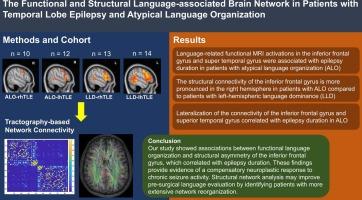颞叶癫痫和非典型语言组织患者的功能和结构语言相关脑网络
IF 2.3
3区 医学
Q2 BEHAVIORAL SCIENCES
引用次数: 0
摘要
背景:有证据表明,癫痫可能导致大脑功能和结构的改变,与健康对照相比,癫痫患者更常观察到非典型语言组织(ALO)。本研究旨在利用概率神经束造影研究颞叶癫痫(TLE)患者左半球语言优势(LLD)和左半球语言优势(ALO)的结构连通性差异。方法选取22例TLE合并ALO患者和27例年龄、性别匹配的LLD患者,采用3特斯拉功能磁共振成像(fMRI)进行术前语言评估。两组根据癫痫发作半球进一步细分。SPM12用于确定基于功能任务的语言模式。基于神经束造影和全脑分割对个体结构连接网络进行了研究。结果与LLD患者相比,ALO患者额下回(IFG)结构连通性表现出更强的右半球偏侧(方差分析,pFDR = 0.030)。与癫痫发作同侧的IFG和颞上回(STG)的FMRI激活与癫痫持续时间呈负相关(未纠正<;0.001)的ALO伴右半球TLE。此外,STG-侧化指数(Pearson相关系数:ρ = 0.714,未校正值= 0.020)和ifg -连系性(ρ = - 0.608,未校正值= 0.036)与ALO患者癫痫持续时间相关。结论各组在结构连通性方面存在一些相似之处。然而,在ALO中检测到IFG右半球连通性增加,显示与癫痫持续时间相关。网络分析可以增强对癫痫重组模式的理解,并有助于改善神经外科手术的结果。本文章由计算机程序翻译,如有差异,请以英文原文为准。

The functional and structural language-associated brain network in patients with temporal lobe epilepsy and atypical language organization
Background
Evidence suggests that epilepsy may contribute to both functional and structural brain alterations, with atypical language organization (ALO) being more frequently observed in epilepsy patients compared to healthy controls. This study aimed to investigate structural connectivity differences between left-hemispheric language dominance (LLD) and ALO in patients with temporal lobe epilepsy (TLE) using probabilistic tractography.
Methods
Twenty-two TLE patients with ALO and 27 age- and sex-matched patients with LLD who underwent pre-surgical language assessment using 3 Tesla functional magnetic resonance imaging (fMRI) were included in this study. Both groups were subdivided further based on the seizure onset hemisphere. SPM12 was used to determine the functional task-based language pattern. Individual structural connectivity network was investigated based on tractography and whole brain segmentation.
Results
In patients with ALO, the structural connectivity of the inferior frontal gyrus (IFG) exhibited stronger lateralization to the right hemisphere compared to LLD patients (ANOVA, pFDR = 0.030). FMRI activations in the IFG and superior temporal gyrus (STG) ipsilateral to seizure onset were negatively associated with epilepsy duration (puncorrected < 0.001) in ALO with right-hemispheric TLE. Furthermore, lateralization index of the STG- (Pearson’s correlation: ρ = 0.714, puncorrected = 0.020) and IFG-connectivity (ρ = −0.608, puncorrected = 0.036) correlated with epilepsy duration in ALO.
Conclusion
Several similarities regarding structural connectivity were detected across all groups. However, increased right-hemispheric connectivity of the IFG was detected in ALO, showing a correlation with epilepsy duration. Network analysis may enhance the understanding reorganization patterns underlying epilepsy and help to improve neurosurgical outcome.
求助全文
通过发布文献求助,成功后即可免费获取论文全文。
去求助
来源期刊

Epilepsy & Behavior
医学-行为科学
CiteScore
5.40
自引率
15.40%
发文量
385
审稿时长
43 days
期刊介绍:
Epilepsy & Behavior is the fastest-growing international journal uniquely devoted to the rapid dissemination of the most current information available on the behavioral aspects of seizures and epilepsy.
Epilepsy & Behavior presents original peer-reviewed articles based on laboratory and clinical research. Topics are drawn from a variety of fields, including clinical neurology, neurosurgery, neuropsychiatry, neuropsychology, neurophysiology, neuropharmacology, and neuroimaging.
From September 2012 Epilepsy & Behavior stopped accepting Case Reports for publication in the journal. From this date authors who submit to Epilepsy & Behavior will be offered a transfer or asked to resubmit their Case Reports to its new sister journal, Epilepsy & Behavior Case Reports.
 求助内容:
求助内容: 应助结果提醒方式:
应助结果提醒方式:


